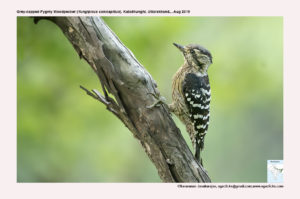
Grey-capped Woodpecker (Dendrocopus canicapillus)
Etymology :
- Dendrocopos : Greek word dendron tree; kopos striking
- Canicapillus : Latin word canus- grey; capillus -capped
Vernacular name : Cachar: Daoja gadaiya meberang, Daoja gadaiya kashiba
Distribution in India: Himalayas and North East India
Description: Size of 14–16 cm; wt. of 20–27 g (mitchellii), 21–32 g (semicoronatus, scintilliceps). The male has grey forehead and crown, black crown sides, hindcrown and nape, small red streak on nape side, buffish nasal tufts. It has white face with grey-brown band through lower ear-coverts, darker at rear and continuing down neck side, narrow brownish malar stripe; whitish chin and throat. It has black upperparts tinged brown, barred white, wing-coverts with variable amount of white at tips; black flight-feathers are tipped white, white spots forming bars on inner wing. The uppertail is black, central feathers are barred or spotted white, outer 2 or 3 pairs are barred whitish; whitish below, breast strongly tinged brownish, dark brown streaks most pronounced on breast; fairly long bill almost straight, barely chisel-tipped, blackish, paler base and lower mandible. The iris is red-brown to grey-brown, orbital skin is grey; legs are greyish to olive-grey. The female lacks red on crown. The juvenile is darker above than adult, with blackish crown, darker below with heavier streaking and often hint of barring. The juvenile male has orange-red on nape and rear crown sides often more extensive than on adult. The races vary in both plumage and size: semicoronatus ( West Assam )has buffish cheek band, strong yellow-brown to buff or even orangey tinge below, differs from all others races in that male has red extending across nape; mitchellii ( Himalayas in North India extending to East) is very like previous, but red on male restricted to narrow lateral nape streak, often more extensive brown on face;
Habitat: It inhabits a great variety of forests and woodlands. It is found from lowlands up to 2800 m.
Food Habits It eats caterpillars, homopteran, small beetles, insect pupae, grubs, Diptera, ants, and fruits, seeds and other plant matter in winter. It is found as solitary, in pairs, or in small family groups. It forages in crowns of tall trees, also at edges of bushes and saplings; seeks out dead twigs or stubs, but most foraging is on outer twigs and branches. It frequently perches crosswise, and hangs on twigs and leaf clusters, often upside-down. It does not peck and hammer at one spot for very long; undertakes much gleaning; occasionally removes a piece of bark or lichen and probes into crevices and at base of leaves. It even flutters to catch less accessible items.
Breeding Habits: They breed in Apr–Jul in Indian Subcontinent and Dec–Apr in SE Asia. The male displays with crest-raising, bill-directing, and slow body-swinging and tail-spreading. The nest is excavated by both sexes, in tree branch, particularly on underside. They lay a clutch of 3–5 eggs. The incubation is done by both sexes. The incubation period is 12–13 days. Both adults also feed chicks. The nestling period is 21 days.